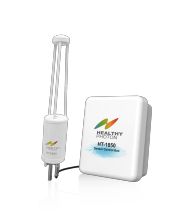 Home - Carbon Asset Data Service - Applications - Paper Overview: Measuring Turbulent Water Vapor Fluxes Using a Tunable Diode Laser-Based Open-Path Gas Analyzer
Home - Carbon Asset Data Service - Applications - Paper Overview: Measuring Turbulent Water Vapor Fluxes Using a Tunable Diode Laser-Based Open-Path Gas Analyzer Water vapor is the most important greenhouse gas in the atmosphere and plays a crucial role in the Earth's water and energy balance. Reliable observation and accurate estimation of atmospheric water vapor (H2O) fluxes are essential for ecosystem management and the development of Earth system models. Currently, Eddy Covariance (EC) technology is widely recognized as the standard method for measuring turbulent fluxes of energy, carbon, and water vapor in various ecosystem types, with the development of this technology relying mainly on fast-response water vapor concentration sensors.
To meet research needs, a high-precision and fast-response open-path laser water vapor analyzer, the HT1800, was developed by the joint research team of HealthyPhoton Technology Co., Ltd. and Wang Kai from the Institute of Atmospheric Physics, Chinese Academy of Sciences, along with the University of Nottingham Ningbo China. This instrument, based on Tunable Diode Laser Absorption Spectroscopy (TDLAS) technology, utilizes a laser source in the near-infrared spectrum (1392 nm) and an open measurement path to achieve high-frequency (10 Hz) continuous measurement of atmospheric water vapor concentration. It captures turbulent fluctuations in water vapor with minimal disturbance and directly obtains the flux exchange between the Earth's surface and the atmosphere based on the principles of turbulent correlation. It is used for measuring latent heat flux, ET flux, and for water vapor correction of other gas fluxes.
The research team prepared two HT1800 open-path water vapor analyzers, with laser wavelengths of 1392 nm and 1877 nm, respectively. Through comparative experiments with two commonly used water vapor analyzers in the European Community, LI-7500RS and IRGASON, the field performance of these two analyzers was evaluated. The water vapor densities measured by the three analyzers showed high overall consistency with the reference sensors. The average density drifts of HT1800, LI-7500, and IRGASON were 3.7%-5.2%, 4.0%, and 3.8%, respectively. Meanwhile, the half-hourly average water vapor fluxes measured by HT1800 were highly consistent with those measured by LI-7500RS and IRGASON, with differences ranging from -0.2% to 1.6%. This indicates that HT1800 can accurately measure water content in the atmosphere. HT1800 is also suitable for application in the European Community due to its data availability, flux detection limit, and response to high-frequency turbulent changes.
Furthermore, the team studied how spectral effects influence the measurement of H2O density and flux. It was found that the laser with a wavelength of 1392 nm is more susceptible to spectral effects, but after correcting for this bias, the flux showed excellent consistency with IRGASON's flux. Considering the cost advantages of lasers and photodetectors, as well as the competitive advantages that will be gained after mass production, this instrument provides an economical and effective self-solution for high-frequency measurement of surface evapotranspiration and correction of water vapor interference effects on other trace gas fluxes.

Fig.1: Comparison of HT1800 Open-Path Water Vapor Analyzer with two imported instruments from the United States (LI-7500RS and IRGASON) in field observations.

Fig.2: Comparison of water vapor concentration and flux measured by HT1800 Open-Path Water Vapor Analyzer with two imported instruments from the United States (LI-7500RS and IRGASON).

HT1800 Open-Path Water Vapor Analyzer:
Reference
Wang K., Huang, L., Zhang, J.T., Zhen, X.J., Shi, L.L., Lin, T.J.*, Zheng X.H., Wang Y.*, 2024. Measuring turbulent water vapor fluxes using a tunable diode laser-based open-path gas analyzer. Water 16(2), 307.
https://doi.org/10.3390/w16020307
 Tel:+86-400 961 6990 Email:info@healthyphoton.com
Add:Room 305, Building 1, Zhongchuang Science Park, Jinyuan Road, Panhuo Street, Yinzhou District, Ningbo City,China
Tel:+86-400 961 6990 Email:info@healthyphoton.com
Add:Room 305, Building 1, Zhongchuang Science Park, Jinyuan Road, Panhuo Street, Yinzhou District, Ningbo City,China


